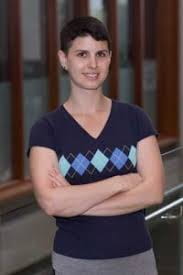How Manmade Chemicals Alter Our Microbial World
In the battle against the bugs, humans are vastly outnumbered.
 Prof. Erica Hartmann cautions against overuse of antimicrobial soaps and chemicals, as these may contribute to more resilient "super bugs."
Prof. Erica Hartmann cautions against overuse of antimicrobial soaps and chemicals, as these may contribute to more resilient "super bugs."
It’s long been estimated that our bodies contain trillions of microorganisms — supposedly a 10-to-1 ratio compared with our cells. While more recent assessments peg that number closer to 1-to-1, that’s still a lot of microbes getting under our skin. Under normal circumstances, most of these organisms are either harmless or actually helpful. Still, these facts don’t stop people from arming themselves with antibacterial soaps, wipes, and other disinfectants, creating the potential to increase antimicrobial resistance, which can adversely impact human health, livestock, and the natural environment.
While commonsense hygiene, including proper handwashing, remains widely recommended, Erica Hartmann(civil and environmental engineering) cautions that the indiscriminate use of our chemical arsenal may work against us. At this month’s Science Café, Hartmann will provide a lay-friendly overview of her research findings in this arena, including new insights about the microbiome in our homes and about how household dust is capable of sharing antibiotic resistant genes.
A Bug’s Life
The world is brimming with microscopic organisms living either as single-celled creatures or in a larger colony, says Hartmann. Not surprisingly, our homes contain their own microbiome too, one that varies based on location, occupants, and general conditions inside the house, such as humidity. (Check out “Community of Microbes” for a fascinating look at your unseen roommates.) When humans “manipulate the microbial landscape through everyday chemicals,” she notes, they induce structural and functional changes in the microbes that can result in the spread of certain bugs over others based on selected traits — such as antibiotic resistance. Her lab uses culture-based microbiological techniques in tandem with genomic sequencing, proteomics (a way of studying proteins), and metabolomics (the study of cellular metabolism) to characterize the effects of chemicals on the indoor microbiome. The research, she says, has important implication for “microbial ecology and antibiotic resistance in real-world buildings.”
The details of what happens at the cellular level when chemicals clash with microbes is complex, but Hartmann says there are typically three basic possibilities: microbes may consume the chemical as a source of nutrient or energy, remove the chemical from the cell, or modify the chemical to mitigate its toxicity. “Or some combination of the three,” she adds.
 Microbes get a bad rap, but our homes and bodies teem with them and most are usually harmless.
Microbes get a bad rap, but our homes and bodies teem with them and most are usually harmless.
Hartmann acknowledges the value of antimicrobial chemicals — particularly when used for, say, decontaminating hospital surfaces or in contexts where sterilization is crucial. But if these chemicals are not used wisely, “the biggest risk is that they won’t work when we need them.”
The use of antibiotics in medical practice continues to be an issue attracting scrutiny — including in a recent Feinberg School study that found that nearly half of clinicians prescribed the drugs even without evidence of infection. Hartmann also sees the ongoing use of antibiotics in agriculture and farming as a significant issue, as well as our continued overuse of non-prescription antimicrobials.
“There are also a lot of other factors that we don’t fully understand, like the relationship between other chemicals — for example, heavy metals — and antibiotic resistance,” she says.
In recent years, the media has picked up studies highlighting the supposed hazards of microbes in the home, including papers like this one detailing the number of bacteria living in your kitchen sponge. Hartmann recalls receiving a “panicked email” from a relative asking how to respond to the threat.
“We forget is that the microbes have always been there,” she says. “They were there before scientists looked for them. So I told my relative to keep doing what he’d always been doing: use the sponge to wash dishes and don’t eat it.”
Come enjoy a lay-friendly presentation of Hartmann’s research on February 26 at Firehouse Grill, 750 W. Chicago Ave. in Evanston from 6:30 to 8:00 p.m.